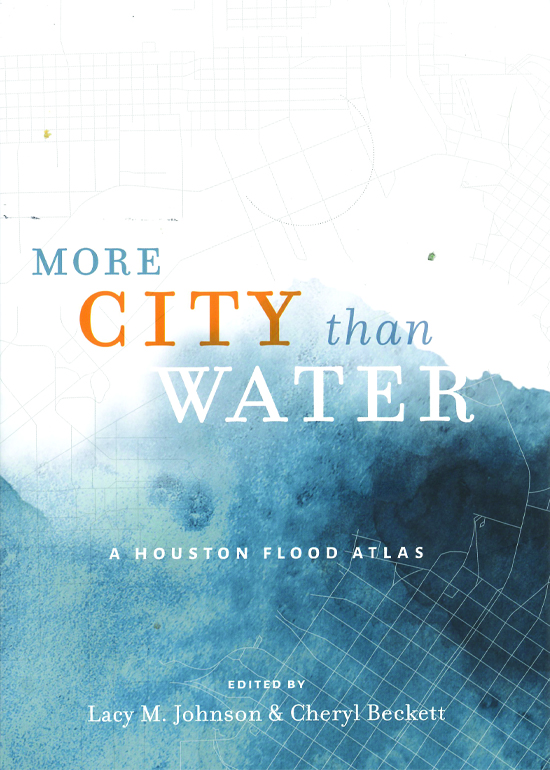Blame It On The Rain

More City Than Water: A Houston Flood Atlas
by Lacy M. Johnson & Cheryl Beckett
Austin: University of Texas Press, 2022.
264 pp. $39.95 Hardcover.
Reviewed by
Adam Clark
Water has been moving to the fore in people’s understanding of Houston. More City Than Water: A Houston Flood Atlas seeks to measure this process in a collection of twenty-two essays divided across three thematic sections: history, memory, and community. As the headings imply, each is tied to these themes and features stories related to Houston’s problematic founding, the city’s various floods (particularly during Hurricane Harvey), and communities coming together when in need. Additionally, the beginning of each essay features a companion map meant to visualize the story being told. The themes and organization work well to tell a robust story of how Houston became the city it is today in terms of its racial inequality and environmental issues.
The first section, “History,” covers the founding of Houston, particularly relating to discriminatory policies that segregated communities of color from white and affluent groups. These communities were designed so that during floods, economically privileged (and white) neighborhoods generally fared well while Black and/or Hispanic communities were destroyed. The essays examine the institutionalized racism experienced by communities of color, both in the past and present. Other essays explore pollution disparities where communities of color are exposed to air and water pollution at a much higher rate, a problem exacerbated during tropical storms and other disasters. Ultimately, “History” explores the connectedness of Houston to the water. For good or bad, and usually both, the two are forever intertwined.
“Memory” focuses on the flooding during Hurricane Harvey. These essays depict property loss, pollution exposure, hurricane preparedness or lack thereof, and generally coming to terms with surviving a disaster. Survivors share accounts of attempting to save their possessions while watching water creep slowly towards, and eventually into, their homes. They also write of hardships communities face in the aftermath of floods and how disasters can bring communities together to help get everyone back to “normal,” whatever the new normal happens to be.
“Community” builds on these themes, beginning with stories of recovery then transitioning into discussion of infrastructure projects, like the bayou system, which are integral to Houston’s flood control plan, but cause problems of their own. Later essays discuss sea level rise, expand on pollution issues and future infrastructure plans, and explore the dangers Houston faces in the future. As someone trained and committed to disaster planning, I personally felt this was the strongest section as it featured more analytical discussions as opposed to more literary storytelling.
The final component of the book are the maps preceding each essay. The maps are not designed to be cartographic tools, but rather artistic representations of space. The authors stating that “what we hope to navigate here is not traffic or congestion, but rather our relationship to the land, to the future, to flooding, and to one another.” They are well made, interesting, and generally convey what they set out to; however, some are fairly abstract and require imagination to decipher. Most, though, are concise and powerful representations, helpful in visualizing the theme of the associated essay. By and large, they are a welcome addition to the narrative.
There is a lot to like about More City Than Water, but like Houston’s flood control systems, it has its weak points. One major thing that stood out was that there were no contributing geographers. A geographic viewpoint would have been welcome considering the book’s premise, and it feels like a missed opportunity to discuss flooding in Houston and not seek out anyone who studies Houston flooding in a geographic sense. This is not to say that there were no experts consulted, there absolutely were, and their essays are some of the best in the book, but at least one geographic perspective would have been a nice addition.
The other (albeit minor) issue was the general content of a few essays. There were several instances where water became a secondary character. These cases detracted from an otherwise cohesive narrative and didn’t contribute to the larger exploration of water and flooding in Houston.
That said, More City Than Water: A Houston Flood Atlas is a solid book with fantastic essays and interviews that address important issues Houston faces with flooding, pollution, institutionalized racism, and the places where they converge. There are serious topics concerning the environmental stability of Houston, and the more people who are informed about them, the better the chances for a positive future for those who depend on Houston and those who call Houston home.
Adam Clark is a Ph.D. candidate in the Department of Geography and Environmental Studies at Texas State University. His dissertation research explores the ways in which hazard maps and related imagery have been used to both inform Houston residents about hazard risk, but also examines how these images have been leveraged metaphorically as commentary a variety of social issues such as crime, urban development, and nationalism. His work has been published in Natural Hazards and The Southwestern Geographer.
